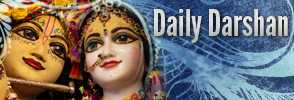Please view the full gallery here:
Rama Navami Abhishek
Darshan
The celebration of Lord Ramacandra`s appearance in Mayapur had a very sweet flavor. The deities of Sri Sri Sita Ram Laksman Hanuman were set in front of the altar of Sri Sri Radha Madhava and Asta sakhis and were beautifully decorated with different ornaments, jewels and fragrant flowers and the devotees were jubilantly dancing and chanting “Raghupati Raghava Raja Ram…”. Before noon devotees lovingly performed the bathing ceremony of the Lord, while sweet kirtan was going on. After the abhishek Lord Ramacandra was offered varieties of delicious and attractive looking food items prepared by many devotees and after relishing the items prepared with devotion, Lord Ram was showered with a rain of flower petals thrown by the lotus hands of the vaisnavas who were surrounding Him.
Lord Ramachandra, also referred to as Lord Rama, is the incarnation of Krishna that appeared in Ayodhya during the Treta Yuga. According to the Vedas, the universe is constantly created and destroyed and each creation is divided in to four yugas, or time periods; Satya Yuga, Treta Yuga, Dvapara Yuga, and the Kali Yuga, which we are currently in.
The reasons for the Lord’s advent were many and they differ slightly for each creation. Lord Krishna says in the Bhagavad-gita that “whenever there is a decline in religion, I personally come Myself to restore the tradition of the Vedas and to protect My devotees”. Prior to Lord Rama’s advent, there was a very powerful demon named Ravana who was wreaking havoc throughout the world and disrupting the sacrifices of the saintly people on earth. The sadhus of the world prayed for the Lord to personally come and save them and He answered their prayers.
There was a great king who ruled over Adyodhya at the time by the name of Dashratha, who was very pious and respected by all. His life was perfect except for the fact that he had no son to whom he could pass down his kingdom. On the advice of his priest Vashishta, Dashratha performed a yajna (Vedic sacrifice) for Lord Vishnu, and in due time his wives gave birth to four beautiful sons named Rama, Bharata, Lakshmana, and Shatrughna.
Lord Rama performed many glorious pastimes during His time on earth, but His most celebrated pastime was His slaying of the demon Ravana, who had abducted His wife Sita. Stories related Lord Rama’s life are beautifully told in the original Ramayana, written by Maharishi Valmiki, who was instructed to write the Ramayana by his spiritual master Narada Muni. Other historical accounts of Lord Rama’s life can be found in almost all of the Puranas (ancient Vedic stories), including the Mahabharata and the Shrimad Bhagavatam (Bhagavata Purana). Around five hundred years, Goswami Tulsidas wrote his own poem detailing the pastimes of Lord Rama, called the Ramacharitamanasa, also known as the Tulsi Ramayana. In this beautiful work, Tulsidas references all the stories of Lord Rama contained in various Vedic literatures, but especially the Valmiki Ramayana and the Brahmananda Purana, and merges them to tell the story of the Ramayana in a mood of devotion and love, and for this reason, it is considered to be one of the most important Vedic literatures.
Lord Rama is considered an avatar of Vasudeva (Lord Krishna), and thus there is no difference between Him and God. He is usually worshipped along with His wife Sita, younger brother Lakshmana, and His greatest devotee Hanuman, collectively known as the Ram Darbar. Lord Rama played the role of a perfect human being, a role model for everyone. He was an ideal son, husband, friend, and king. He had no other interest in His mind other than to please His devotees and to serve them. Recitation of Lord Rama’s name is the only means of salvation in this age of Kali as it will immediately remind us of His beautiful form and wonderful pastimes.


















Recent Comments